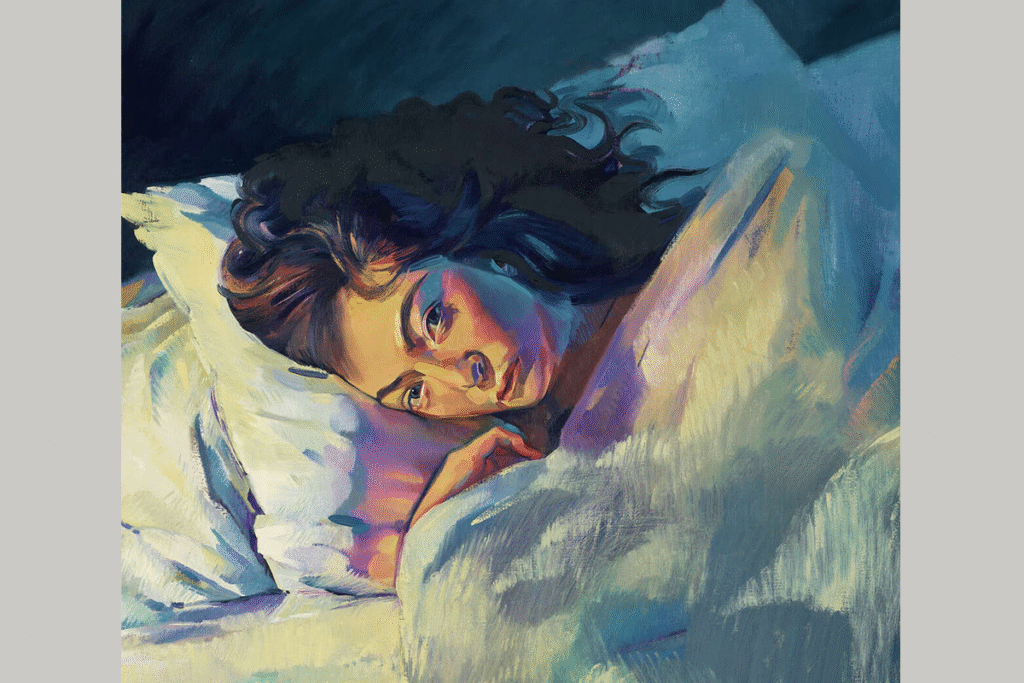Sam McKinnis, Lorde (Melodrama), 2016. Wadsworth Atheneum Museum of Art, Hartford, Connecticut
 Some faces are meant to be seen, but others are intended to be felt. I was walking into the Wadsworth Atheneum Museum when I was immediately struck by a contemporary painting that was curiously positioned in the Impressionist gallery of the Museum. Sam McKinniss’ Lorde (Melodrama) is an oil and acrylic painting on canvas that captures the New Zealand singer Ella Yelich-O’Connor, widely known as Lorde, in a dreamlike glow.
Some faces are meant to be seen, but others are intended to be felt. I was walking into the Wadsworth Atheneum Museum when I was immediately struck by a contemporary painting that was curiously positioned in the Impressionist gallery of the Museum. Sam McKinniss’ Lorde (Melodrama) is an oil and acrylic painting on canvas that captures the New Zealand singer Ella Yelich-O’Connor, widely known as Lorde, in a dreamlike glow.
Her face is bathed by a soft and radiant light framing the dark waves of her hair. Her expression is quite mysterious, revealing a gaze that embodies a blend of emotions, including longing, resignation, wrath, and sadness, as she is caught between waking and sleep. The background is endowed with dark blues and purples, while McKinniss’ brushwork is fluid and expressive with an apparent lack of line, showing an influence of Romanticism and Realism in the artist’s work, where the “chromatic contrasts, used so clinically… become the vehicle of intense passion. (1)”
At first glance, I was captivated by the enigmatic scene. However, as I paid closer attention, I perceived a vulnerability in Lorde’s expression hidden underneath her gestures of surprise and wrath. The longer one observes, the more the painting reveals the play of light on her skin, with thin brushstrokes that recall artists such as Édouard Manet, Claude Monet, and Vincent Van Gogh, who can also be observed in the same gallery, immersing the viewer in a mysterious and melancholic scene.
“The museum purchased the painting in the fall of 2022 after working with McKinniss and his New York-based studio, according to a spokesperson for the Wadsworth Atheneum Museum of Art. McKinniss, who grew up in Connecticut and attended Hartford Art School, held onto the painting for years before selling it to the museum [sic]”(2).
Reflecting on this contemporary painting, I appreciate how McKinniss utilized a musical album cover to depict an artist, creating an image that mediates between fame and solitude —a sentiment that a singer like Lorde likely experiences in their career. In this portrait, many things are waiting to be said, and probably, they will not be said, at least not with words, but with an image, where a simple painting speaks more than a hundred words, making the viewer feel understood better than they themselves. In short, this masterpiece portrays someone who has wrestled with their melodrama.
Finally, as a legionary brother in formation, I would use this painting to speak about the human condition. The portrait captures the restlessness of the human heart, which is always longing for something beyond itself, reminding me of St. Augustine’s famous words: “Our hearts are restless until they rest in You.” Just as McKinniss’ Lorde (Melodrama) expresses the ache of an existence where happiness and success are wrongly misunderstood, this painting could serve as a starting point for discussing the desire for meaning, peace, and the beauty of human emotion as a reflection of the divine.
Foot notes
- Walford, Great Themes in Art, Prentice All, China 2001, 415.
- A. DaRosa, Lorde’s ‘Melodrama’ alternate cover art on view at Wadsworth Museum in Hartford, May 24, 2023, in https://www.ctinsider.com/entertainment/article/lorde-melodrama-painting-wadsworth-museum-hartford-18114043.php, (Referenced on February 9th, 2025)



